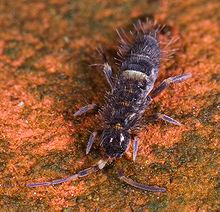
A passerine is any bird of the order Passeriformes which includes more than half of all bird species. Sometimes known as perching birds, passerines generally have an anisodactyl arrangement of their toes, which facilitates perching.

Fauna is all of the animal life present in a particular region or time. The corresponding terms for plants and fungi are flora and funga, respectively. Flora, fauna, funga and other forms of life are collectively referred to as biota. Zoologists and paleontologists use fauna to refer to a typical collection of animals found in a specific time or place, e.g. the "Sonoran Desert fauna" or the "Burgess Shale fauna". Paleontologists sometimes refer to a sequence of faunal stages, which is a series of rocks all containing similar fossils. The study of animals of a particular region is called faunistics.

The Pentatomomorpha comprise an infraorder of insects in the true bug order Hemiptera. It unites such animals as the shield- or stink-bugs, flat bugs (Aradidae), seed bugs, etc. They are closely related to the Cimicomorpha.

Ericiolacerta is an extinct genus of small therocephalian therapsids from the early Triassic of South Africa and Antarctica. Ericiolacerta, meaning "hedgehog lizard", was named by D.M.S. Watson in 1931. The species E. parva is known from the holotype specimen which consists of a nearly complete skeleton found in the Lystrosaurus Assemblage Zone within the Katberg Formation of the Beaufort Group in South Africa, and from a partial jaw found in the Lower Triassic Fremouw Formation in Antarctica. Ericiolacerta was around 20 centimetres (7.9 in) in length, with long limbs and relatively small teeth. It probably ate insects and other small invertebrates. The therocephalians – therapsids with mammal-like heads – were abundant in Permian times, but only a few made it into the Triassic. Ericiolacerta was one of those. It is possible that they gave rise to the cynodonts, the only therapsid group to survive into post-Triassic times. Cynodonts gave rise to mammals.

The Entognatha are a class of wingless and ametabolous arthropods, which, together with the insects, makes up the subphylum Hexapoda. Their mouthparts are entognathous, meaning that they are retracted within the head, unlike the insects. Entognatha are apterous, meaning that they lack wings. The class contains three orders: Collembola, Diplura and Protura. These three groups were historically united with the now-obsolete order Thysanura to form the class Apterygota, but it has since been recognized that the hexapodous condition of these animals has evolved independently from that of insects, and independently within each order. The orders might not be closely related, and Entognatha is now considered to be a paraphyletic group.
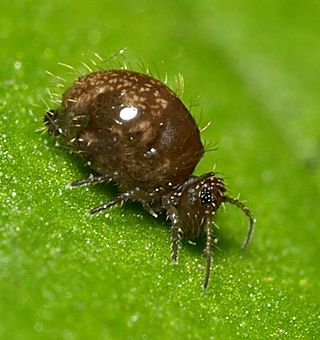
The order Symphypleona, also known as the globular springtails, is one of the three main groups of springtails (Collembola), tiny hexapods related to insects. When the springtails were still believed to be an order of insects, the Symphypleona were ranked as a suborder.

The Entomobryomorpha are one of the three main groups (order) of springtails (Collembola), tiny hexapods related to insects. This group was formerly treated as a superfamily, the Entomobryoidea.

The order Poduromorpha is one of the three main groups of springtails (Collembola), tiny hexapods related to insects. This group was formerly treated as a superfamily Poduroidea.

The subfamily Neanurinae contains pudgy short-legged springtails of the order Poduromorpha. It was established by Carl Börner in 1901 – or rather, it is the result of taxa being split out of Börner's family whereas the type genus and its closest relatives were retained here.

Neelipleona is a name given to some hexapods of the subclass Collembola (springtails). While their taxonomic rank remains broadly settled as family Neelidae, Neelipleona has been described at order or suborder rank. Eyes are absent.

Megawhaitsia is an extinct genus of large therocephalian therapsids who lived during the Late Permian (Wuchiapingian) in what is now Eastern Europe. The only known species is M. patrichae, described in 2008 from several fossils discovered in various oblasts of European Russia. The fossils are representative of a large animal whose skull size is estimated to be 40–50 cm (16–20 in) long.
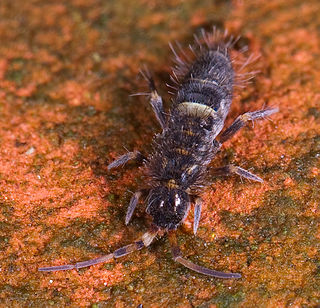
Springtails form the largest of the three lineages of modern hexapods that are no longer considered insects. Although the three orders are sometimes grouped together in a class called Entognatha because they have internal mouthparts, they do not appear to be any more closely related to one another than they are to all insects, which have external mouthparts.
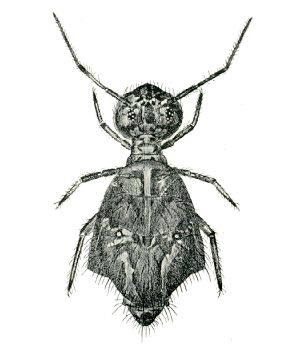
Sminthuridae, not to be confounded with: Sminthurididae, is a family of springtails of the order Symphypleona. Sminthurids are commonly referred to as globular springtails.

Chaetotaxy is the arrangement of bristles (macrochaetae) on an arthropod or annelid, or taxonomy based on their position and size. For example, it is important in Diptera, in which group it was formalised by Ernst August Girschner. The term chaetotaxy was later proposed by Carl Robert Osten-Sacken.

The subphylum Hexapoda or hexapods comprises the largest clade of arthropods and includes most of the extant arthropod species. It includes the crown group class Insecta, as well as the much smaller clade Entognatha, which includes three classes of wingless arthropods that were once considered insects: Collembola (springtails), Protura (coneheads) and Diplura. The insects and springtails are very abundant and are some of the most important pollinators, basal consumers, scavengers/detritivores and micropredators in terrestrial environments.
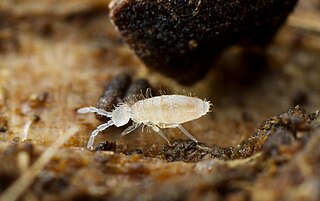
Paronellidae is a family of elongate-bodied springtails in the order Entomobryomorpha. There are about 18 genera and at least 90 described species in Paronellidae.
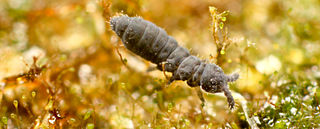
Hypogastruroidea is a superfamily of springtails in the order Poduromorpha. There are at least 2 families and more than 700 described species in Hypogastruroidea.
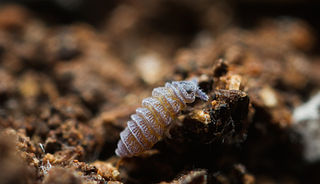
Onychiuroidea is a superfamily of springtails in the order Poduromorpha. There are about 5 families and more than 630 described species in Onychiuroidea.
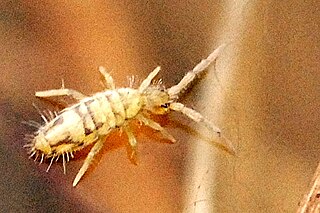
Entomobrya nivalis, the cosmopolitan springtail, is a species of slender springtails in the family Entomobryidae.

Cyphoderus is a genus of elongate-bodied springtails in the family Paronellidae. There are more than 20 described species in Cyphoderus.
